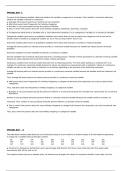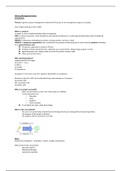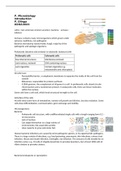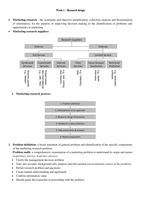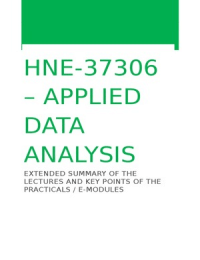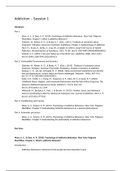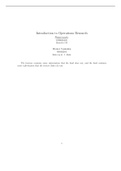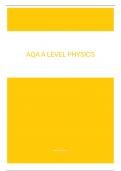Geografisch informatiesysteem (GIS)
1. Algemene informatie ...........................................................................................................................1
1.1. Eindcompetenties .......................................................................................................................................1
1.2. Examen .......................................................................................................................................................1
1.3. Doel ............................................................................................................................................................1
1.4. Inhoud ........................................................................................................................................................1
1.5. GIS ..............................................................................................................................................................1
2. Inleiding ...............................................................................................................................................2
2.1. GIS: introductie ...........................................................................................................................................2
2.1.1. Wat is GIS? .....................................................................................................................................................................2
2.1.2. Formaten .......................................................................................................................................................................5
2.1.3. Schaal.............................................................................................................................................................................7
2.2. Software .....................................................................................................................................................8
2.2.1. QGIS verkennen .............................................................................................................................................................8
2.2.2. Dataformaten ..............................................................................................................................................................12
2.2.3. Werken met tabellen ...................................................................................................................................................13
3. Cartografie .........................................................................................................................................14
3.1. Cartografie ................................................................................................................................................14
3.2. Thematische kaarten ................................................................................................................................14
3.2.1. Basisregels ...................................................................................................................................................................14
3.3. Choropletenkaart ......................................................................................................................................18
3.3.1. Klasse indeling .............................................................................................................................................................21
3.3.2. Probleem van klassegrenzen .......................................................................................................................................23
3.4. Figuratieve kaart .......................................................................................................................................24
3.5. Lay-out .....................................................................................................................................................24
3.5.1. Labels ...........................................................................................................................................................................24
3.5.2. Lay-out .........................................................................................................................................................................24
3.6. QGIS Projecten..........................................................................................................................................28
3.7. Nominale variabele weergeven (gewestpan) .............................................................................................29
3.8. Print layout (printomgeving) .....................................................................................................................30
3.8.1. Printomgeving..............................................................................................................................................................37
3.9. 2.5D ..........................................................................................................................................................39
3.9.1. 2.5D – 3D .....................................................................................................................................................................39
3.9.2. 2.5D weergave van choropletenkaart ..........................................................................................................................40
3.9.3. DEM .............................................................................................................................................................................41
3.9.4. Historisch landschap weergeven in 2.5D .....................................................................................................................42
4. GIS-data creëren en toevoegen ..........................................................................................................45
4.1. Kaartprojecties en coördinatensystemen ..................................................................................................45
4.2. Projecties en coördinaten .........................................................................................................................45
4.2.1. CRS instellen en wijzigen .............................................................................................................................................47
4.2.2. Georefereren ...............................................................................................................................................................49
4.3. Data intypen in attributentabel .................................................................................................................54
4.4. Data berekenen ........................................................................................................................................55
4.5. Joins .........................................................................................................................................................57
, 4.6. XY data toevoegen ....................................................................................................................................58
4.6.1. Adressen geocoderen ..................................................................................................................................................59
4.6.2. Zelf tekenen .................................................................................................................................................................60
5. Ruimtelijke Analyse ............................................................................................................................63
5.1. Analysis Tools ...........................................................................................................................................63
5.1.1. Points in Polygon .........................................................................................................................................................63
5.1.2. Nearest Neighbour Analysis.........................................................................................................................................64
5.1.3. Meancoordinates .........................................................................................................................................................64
5.2. Research Tools ..........................................................................................................................................65
5.2.1. Select by location .........................................................................................................................................................65
5.3. Geoprocessing Tools .................................................................................................................................65
5.3.1. Buffer ...........................................................................................................................................................................67
5.3.2. Intersect .......................................................................................................................................................................68
5.3.3. Union ...........................................................................................................................................................................71
5.3.4. Clip ...............................................................................................................................................................................72
5.3.5. Difference ....................................................................................................................................................................72
5.3.6. Dissolve ........................................................................................................................................................................73
5.4. Geometry Tools.........................................................................................................................................74
5.4.1. Polygon Centroids ........................................................................................................................................................74
5.5. Flow-Charts (belangrijk voor examen) .......................................................................................................75
5.5.1. Stroomschema .............................................................................................................................................................75
5.6. Oefeningen ...............................................................................................................................................77
5.6.1. Stations-arrondissement .............................................................................................................................................77
5.6.2. Straten op 500m van de Blindestraat ..........................................................................................................................78
5.6.3. Gebieden in Nijlen binnen een beschermingszone .....................................................................................................78
5.6.4. Inwoners binnen bereik van station ............................................................................................................................78
5.6.5. Grondgebied ................................................................................................................................................................78
6. GIS voor Ruimtelijke Planners in de praktijk .......................................................................................79
6.1. Analyse .....................................................................................................................................................79
6.1.1. Puntdata analyseren: oefening ....................................................................................................................................80
6.2. Ruimtelijke data-analyse ...........................................................................................................................82
6.2.1. Inleiding .......................................................................................................................................................................82
6.2.2. Ruimtelijke data in statistiek ........................................................................................................................................82
6.2.3. Praktische toepassing ..................................................................................................................................................85
6.2.4. Zelf aan de slag ............................................................................................................................................................87
6.3. GIS in onderzoek .......................................................................................................................................93
6.4. Planning support systems (PSS) .................................................................................................................96
6.5. Plannen- en vergunningenregister, verwerking omgevingsvergunningen ...................................................98
6.5.1. Nood aan GIS in dienst Stedenbouw ...........................................................................................................................99
6.5.2. Hoe kan Cevi helpen? ..................................................................................................................................................99
6.5.3. Indeling GIS-aanbod CEVI ..........................................................................................................................................100
6.5.4. Rapportering ..............................................................................................................................................................102
6.5.5. Externe rapporten .....................................................................................................................................................105
,
, 1. Algemene informatie
1.1. Eindcompetenties
• Studenten hebben inzicht in de theorie en praktijk van geografische informatiesystemen en de
mogelijke toepassingen van geografische informatiesystemen.
• Studenten kunnen geografische informatiesystemen gebruiken om ruimtelijke data weer te geven.
• Studenten kunnen geografische informatiesystemen gebruiken voor ruimtelijke analyses
• GIS is meer dan kaarten tekenen, het omvat ook analyse
• Het is niet omdat er een kaart of een ander resultaat te zien is, dat dit ook een goede kaart of een
correct resultaat is.
• In de lessen zullen richtlijnen worden gegeven over welke types kaart in dit opleidingsonderdeel
verwacht worden
1.2. Examen
• Schriftelijk werkstuk (zonder mondelinge toelichting)
• Geen traditioneel (schriftelijk of mondeling) examen
• Opdracht: analyse maken en rapport indienen via Studentenportaal
• Alle informatie over de examenopdracht komt op Studentenportaal
1.3. Doel
• Kunnen werken met GIS-software (concreet: QGIS; maar er bestaan alternatieven)
• Basisprincipes
• Te onthouden:
o Een software aanleren = proberen, opzoeken, knoeien, …
o GIS is er om u te helpen
o Achter software zit er theorie en methodologie
o Meestal zijn er meerdere mogelijke wegen naar de oplossing
1.4. Inhoud
• Module 1: inleiding
• Module 2: cartografie
• Module 3: CRS, GIS-data creëren en toevoegen
• Module 4: ruimtelijke analyse
• Module 5: GIS in de planningspraktijk
1.5. GIS
Leerstof: alles staat op Studentenportaal
• Dia’s
• Bijkomende documenten
• Databestanden
• Examenopdracht
Software (QGIS) is beschikbaar in computerlokalen, maar kan ook vrij gedownload worden. Er is echter
geen ICT-ondersteuning voorzien voor de eigen computer.
• Vragen:
o QGIS helppagina’s, internetfora (gis.stackexchange.com, github.com,…)
o Tijdens contactmomenten
o E-mail
• Feedback examen
o Maak afspraak per e-mail
1
1. Algemene informatie ...........................................................................................................................1
1.1. Eindcompetenties .......................................................................................................................................1
1.2. Examen .......................................................................................................................................................1
1.3. Doel ............................................................................................................................................................1
1.4. Inhoud ........................................................................................................................................................1
1.5. GIS ..............................................................................................................................................................1
2. Inleiding ...............................................................................................................................................2
2.1. GIS: introductie ...........................................................................................................................................2
2.1.1. Wat is GIS? .....................................................................................................................................................................2
2.1.2. Formaten .......................................................................................................................................................................5
2.1.3. Schaal.............................................................................................................................................................................7
2.2. Software .....................................................................................................................................................8
2.2.1. QGIS verkennen .............................................................................................................................................................8
2.2.2. Dataformaten ..............................................................................................................................................................12
2.2.3. Werken met tabellen ...................................................................................................................................................13
3. Cartografie .........................................................................................................................................14
3.1. Cartografie ................................................................................................................................................14
3.2. Thematische kaarten ................................................................................................................................14
3.2.1. Basisregels ...................................................................................................................................................................14
3.3. Choropletenkaart ......................................................................................................................................18
3.3.1. Klasse indeling .............................................................................................................................................................21
3.3.2. Probleem van klassegrenzen .......................................................................................................................................23
3.4. Figuratieve kaart .......................................................................................................................................24
3.5. Lay-out .....................................................................................................................................................24
3.5.1. Labels ...........................................................................................................................................................................24
3.5.2. Lay-out .........................................................................................................................................................................24
3.6. QGIS Projecten..........................................................................................................................................28
3.7. Nominale variabele weergeven (gewestpan) .............................................................................................29
3.8. Print layout (printomgeving) .....................................................................................................................30
3.8.1. Printomgeving..............................................................................................................................................................37
3.9. 2.5D ..........................................................................................................................................................39
3.9.1. 2.5D – 3D .....................................................................................................................................................................39
3.9.2. 2.5D weergave van choropletenkaart ..........................................................................................................................40
3.9.3. DEM .............................................................................................................................................................................41
3.9.4. Historisch landschap weergeven in 2.5D .....................................................................................................................42
4. GIS-data creëren en toevoegen ..........................................................................................................45
4.1. Kaartprojecties en coördinatensystemen ..................................................................................................45
4.2. Projecties en coördinaten .........................................................................................................................45
4.2.1. CRS instellen en wijzigen .............................................................................................................................................47
4.2.2. Georefereren ...............................................................................................................................................................49
4.3. Data intypen in attributentabel .................................................................................................................54
4.4. Data berekenen ........................................................................................................................................55
4.5. Joins .........................................................................................................................................................57
, 4.6. XY data toevoegen ....................................................................................................................................58
4.6.1. Adressen geocoderen ..................................................................................................................................................59
4.6.2. Zelf tekenen .................................................................................................................................................................60
5. Ruimtelijke Analyse ............................................................................................................................63
5.1. Analysis Tools ...........................................................................................................................................63
5.1.1. Points in Polygon .........................................................................................................................................................63
5.1.2. Nearest Neighbour Analysis.........................................................................................................................................64
5.1.3. Meancoordinates .........................................................................................................................................................64
5.2. Research Tools ..........................................................................................................................................65
5.2.1. Select by location .........................................................................................................................................................65
5.3. Geoprocessing Tools .................................................................................................................................65
5.3.1. Buffer ...........................................................................................................................................................................67
5.3.2. Intersect .......................................................................................................................................................................68
5.3.3. Union ...........................................................................................................................................................................71
5.3.4. Clip ...............................................................................................................................................................................72
5.3.5. Difference ....................................................................................................................................................................72
5.3.6. Dissolve ........................................................................................................................................................................73
5.4. Geometry Tools.........................................................................................................................................74
5.4.1. Polygon Centroids ........................................................................................................................................................74
5.5. Flow-Charts (belangrijk voor examen) .......................................................................................................75
5.5.1. Stroomschema .............................................................................................................................................................75
5.6. Oefeningen ...............................................................................................................................................77
5.6.1. Stations-arrondissement .............................................................................................................................................77
5.6.2. Straten op 500m van de Blindestraat ..........................................................................................................................78
5.6.3. Gebieden in Nijlen binnen een beschermingszone .....................................................................................................78
5.6.4. Inwoners binnen bereik van station ............................................................................................................................78
5.6.5. Grondgebied ................................................................................................................................................................78
6. GIS voor Ruimtelijke Planners in de praktijk .......................................................................................79
6.1. Analyse .....................................................................................................................................................79
6.1.1. Puntdata analyseren: oefening ....................................................................................................................................80
6.2. Ruimtelijke data-analyse ...........................................................................................................................82
6.2.1. Inleiding .......................................................................................................................................................................82
6.2.2. Ruimtelijke data in statistiek ........................................................................................................................................82
6.2.3. Praktische toepassing ..................................................................................................................................................85
6.2.4. Zelf aan de slag ............................................................................................................................................................87
6.3. GIS in onderzoek .......................................................................................................................................93
6.4. Planning support systems (PSS) .................................................................................................................96
6.5. Plannen- en vergunningenregister, verwerking omgevingsvergunningen ...................................................98
6.5.1. Nood aan GIS in dienst Stedenbouw ...........................................................................................................................99
6.5.2. Hoe kan Cevi helpen? ..................................................................................................................................................99
6.5.3. Indeling GIS-aanbod CEVI ..........................................................................................................................................100
6.5.4. Rapportering ..............................................................................................................................................................102
6.5.5. Externe rapporten .....................................................................................................................................................105
,
, 1. Algemene informatie
1.1. Eindcompetenties
• Studenten hebben inzicht in de theorie en praktijk van geografische informatiesystemen en de
mogelijke toepassingen van geografische informatiesystemen.
• Studenten kunnen geografische informatiesystemen gebruiken om ruimtelijke data weer te geven.
• Studenten kunnen geografische informatiesystemen gebruiken voor ruimtelijke analyses
• GIS is meer dan kaarten tekenen, het omvat ook analyse
• Het is niet omdat er een kaart of een ander resultaat te zien is, dat dit ook een goede kaart of een
correct resultaat is.
• In de lessen zullen richtlijnen worden gegeven over welke types kaart in dit opleidingsonderdeel
verwacht worden
1.2. Examen
• Schriftelijk werkstuk (zonder mondelinge toelichting)
• Geen traditioneel (schriftelijk of mondeling) examen
• Opdracht: analyse maken en rapport indienen via Studentenportaal
• Alle informatie over de examenopdracht komt op Studentenportaal
1.3. Doel
• Kunnen werken met GIS-software (concreet: QGIS; maar er bestaan alternatieven)
• Basisprincipes
• Te onthouden:
o Een software aanleren = proberen, opzoeken, knoeien, …
o GIS is er om u te helpen
o Achter software zit er theorie en methodologie
o Meestal zijn er meerdere mogelijke wegen naar de oplossing
1.4. Inhoud
• Module 1: inleiding
• Module 2: cartografie
• Module 3: CRS, GIS-data creëren en toevoegen
• Module 4: ruimtelijke analyse
• Module 5: GIS in de planningspraktijk
1.5. GIS
Leerstof: alles staat op Studentenportaal
• Dia’s
• Bijkomende documenten
• Databestanden
• Examenopdracht
Software (QGIS) is beschikbaar in computerlokalen, maar kan ook vrij gedownload worden. Er is echter
geen ICT-ondersteuning voorzien voor de eigen computer.
• Vragen:
o QGIS helppagina’s, internetfora (gis.stackexchange.com, github.com,…)
o Tijdens contactmomenten
o E-mail
• Feedback examen
o Maak afspraak per e-mail
1

